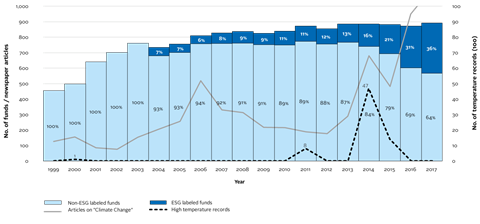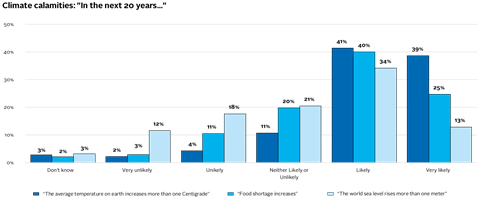By Anders Anderson, Executive Director, Swedish House of Finance and David Robinson, Professor of Finance at Fuqua School of Business, Duke University
Today the world stands captivated in horror, gripped by scenes of environmental devastation, property damage and the tragic loss of life, as Australian bushfires continue to engulf that continent. And while some people may debate whether natural drought cycles, poor environmental management policies, or other factors are ultimately responsible for these fires, the overwhelming message in the public sphere has been that these fires serve as a wake-up call: climate change is real and its consequences are closing in on us quickly. Indeed, a recent survey from the Environmental Policy Institute at the University of Chicago finds that extreme weather events are the number one reason people have changed their views on climate change in the last five years.
Extreme weather events may serve as a wake-up call, affecting people’s views about climate change, but do they actually change people’s behaviour? Importantly, do extreme weather events change only the day-to-day decisions that people make, or do they change the long-run, investment-savings decisions that individuals make?
To tackle this question, we recently conducted a survey in Sweden to ask people about their views on the environment. The survey contains questions about both financial and environmental knowledge and beliefs about future climate-related calamities such as global temperature increases, food shortages and rising sea levels. We then matched our survey responses to detailed government registry data on household socio-economic status, weather events and retirement savings choices. This allows us to not only connect beliefs about calamities to exposure to actual weather calamities, but also match these data with broader measures of financial and environmental knowledge and sophistication to actual investment decisions.
To identify the effect of extreme weather events on individuals’ views about long-term financial decisions, we took advantage of the fact that the summer of 2014 saw the highest temperatures on record throughout many parts of Scandinavia. These unusually high temperatures were associated with an excessive number of weather-related anomalies, such as droughts, floods and thunderstorms in many places of the country. Indeed, one of the worst wildfires in Sweden since the 1950s occurred that summer, destroying an area the size of the District of Columbia. These weather calamities captured the public imagination but affected people differently based on where they lived.
This can be seen in Figure 1. The dotted line in Figure 1 displays the number of average heat records, and show that 47 out of 100 weather stations reported new highs in 2014. The grey bold line displays the number of newspaper articles on climate change in the four largest newspapers. Clearly, people were talking about the weather in Sweden after 2014.

We found that these extreme weather events not only shaped opinions about the environment, causing individuals living in areas with more severe weather shocks to form more extreme expectations about the likelihood of future weather events, but that these expectations increase the likelihood of investing in mutual funds claiming to invest with environmental sustainability in mind.
More specifically, many survey respondents reported that future climate-related catastrophes are very likely, far more likely than would be implied by the accepted scientific consensus for the worst-case scenario. Figure 2 shows that 39% believe that the world temperature will increase by more than one degree Celsius in just twenty years, and 13% that the world sea level will rise by more than one meter within the same time-span. Such dramatic climate changes lie well outside even the most pessimistic predictions published by Nasa and the UN.

We find these beliefs are more likely to be held by individuals who live in areas that were more dramatically affected by weather calamities. Next, we connect climate calamities to exposure to weather. We find that the propensity to think any of the climate calamities in Figure 2 to be very likely is more prevalent in regions experiencing heat records in Figure 1. This shows how the weather affected opinions about imminent climate change.
To explore the mechanisms that connect beliefs to green mutual fund investing, we asked respondents a series of questions about their beliefs and behaviours. Respondents who overweight future environmental calamities are more likely to think that green investments outperform, and they state that they are willing to pay higher fees for funds that adhere to ESG guidelines. More generally, they claim that they are willing to pay more for environmentally sustainable products and they believe that they recycle much more than their neighbors do. These results suggest that fears about rapidly changing climate induced by extreme weather events ignite a “call to action” whereby affected respondents feel an imperative to change their consumption and investment behaviours to align with environmental sustainability.
Finally, we connect climate calamities to actual investment decisions, looking at whether they can explain the rapid increase in green funds presented in Figure 1, and asking how that connection plays out. We find that people who fear rapid climate change are more likely to hold ESG funds. This effect is not driven by passively holding funds that are relabeled with ESG labels to attract investors; instead, we find that investors who have heard this “call to action” have actively traded out of their old portfolios into ESG-labeled funds.
Our results are well-founded in psychology: the salience of events is shown to drives peoples’ attention, but also the likelihood of events through an availability bias. Emotional responses affect risk assessments, where the tendency to overweight low probability extreme events is one of the distinct features of Tversky’s and Kahneman’s prospect theory. Indeed, the fact that increased exposure to localised weather shocks increases the probability of holding such beliefs suggests that these beliefs arise from a recency or availability bias.
Our results speak directly to a mechanism in which beliefs about climate change are in part driven by an availability bias based on past personal experience. As more extreme weather is expected with climate change, we predict that this effect will only become stronger going forward.
This blog is written by academic guest contributors. Our goal is to contribute to the broader debate around topical issues and to help showcase research in support of our signatories and the wider community.
Please note that although you can expect to find some posts here that broadly accord with the PRI’s official views, the blog authors write in their individual capacity and there is no “house view”. Nor do the views and opinions expressed on this blog constitute financial or other professional advice.
If you have any questions, please contact us at [email protected].












